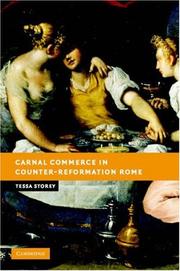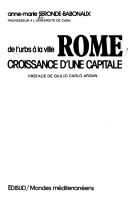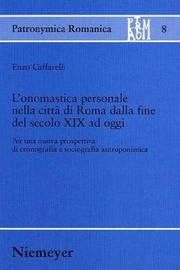| Listing 1 - 6 of 6 |
Sort by
|

ISBN: 9781107406575 9780521844338 0521844339 Year: 2008 Publisher: Cambridge New York Melbourne Cambridge university press
Abstract | Keywords | Export | Availability | Bookmark
 Loading...
Loading...Choose an application
- Reference Manager
- EndNote
- RefWorks (Direct export to RefWorks)
Social problems --- anno 1600-1699 --- anno 1500-1599 --- Rome --- Prostitutes --- Prostitution --- History --- Social conditions --- Rome (Italy) --- Prostitution - Italy - Rome - History - 16th century --- Prostitution - Italy - Rome - History - 17th century --- Prostitutes - Italy - Rome - Social conditions - 16th century --- Prostitutes - Italy - Rome - Social conditions - 17th century --- Rome (Italy) - Social conditions - 16th century --- Rome (Italy) - Social conditions - 17th century

ISBN: 2857440618 9782857440611 Year: 1980 Publisher: [Aix-en-Provence] : Edisud,
Abstract | Keywords | Export | Availability | Bookmark
 Loading...
Loading...Choose an application
- Reference Manager
- EndNote
- RefWorks (Direct export to RefWorks)
City planning --- Urbanisme --- Rome (Italy) --- Rome (Italie) --- Economic conditions. --- Social conditions. --- Conditions économiques --- Conditions sociales --- Economic conditions --- Social conditions --- Conditions économiques --- City planning - Italy - Rome --- Rome (Italy) - Economic conditions --- Rome (Italy) - Social conditions

ISSN: 09383387 ISBN: 3484555084 3110911795 9783110911794 9783484555082 Year: 1996 Volume: 8 Publisher: Tubingen : M. Niemeyer,
Abstract | Keywords | Export | Availability | Bookmark
 Loading...
Loading...Choose an application
- Reference Manager
- EndNote
- RefWorks (Direct export to RefWorks)
Senza trascurare la ricerca etimologica per le forme rare, la ricerca punta a: valutare tendenze e flussi dell'onomastica romana utilizzando una serie innovativa di indici statistici (dispersione, originalità, semiuniverso, conformismo, concentrazione, nomi dominanti, nomi ad altra frequenza, coefficiente demografico); individuare se nella formazione delle mode una ripartizione areale anticipi l'altra e se la grande città preceda i piccoli centri; rilevare l'eventuale esistenza di forme nominali socialmente connotate; confrontare i nomi personali dei residenti in Roma nativi con i nomi dei residenti non nativi, per valutare se esista - e quali aspetti eventualmente assuma - un'onomastica parallela degli immigrati italiani nella capitale; esaminare allotropi, varianti e alterati, con particolare attenzione alla microvariantistica. Inoltre lo studio intende verificare con criteri di cronografia e sociografia onomastica la scelta di nomi personali da parte di autori romani - nei campi della letteratura, teatro, cinema, sceneggiati televisivi, canzoni - per valutare quali influenze abbiano maggiormente inciso nel battesimo dei personaggi, tentando di formulare ipotesi nel merito del processo di formazione delle mode. Tabelle e grafici documentano gli aspetti più prettamente statistici, connotano le forme lungo l'asse diatopico, diacronico e diastratico; evidenziano le varianti meno comuni. Il tentativo di collocare la situazione romana in un quadro europeo o mondiale risponde non soltanto all'esigenza di una necessaria comparazione, ma anche all'attualità del moltiplicarsi dei contatti interlinguistici e delle forme nominali allotrie tra i cittadini italiani.
Names, Personal - Italy - Rome. --- Names, Personal -- Italy -- Rome. --- Rome (Italy) - Social conditions. --- Rome (Italy) -- Social conditions. --- Urban anthropology - Italy - Rome. --- Urban anthropology -- Italy -- Rome. --- Urban anthropology --- Anthropology, Urban --- Rome (Italy : Commune) --- Rome (Italy : Governatorato) --- Rūmah (Italy) --- Roma (Italy) --- Rom (Italy) --- Rím (Italy) --- Rzym (Italy) --- Comune di Roma (Italy) --- Names, Personal --- Ethnology --- Anthroponomy --- Baby names --- Christian names --- Family names --- Forenames --- Names of families --- Names of persons --- Personal names --- Surnames --- Names --- Onomastics --- Rome (Italy) --- Rome --- Social conditions. --- Noms de personnes --- Anthropologie urbaine --- Rome (Italie) --- Conditions sociales --- Rome (Italy : Comune)
Book
ISBN: 0253013011 9780253013019 9780253012883 0253012880 9780253012951 0253012953 Year: 2014 Publisher: Bloomington Indiana University Press
Abstract | Keywords | Export | Availability | Bookmark
 Loading...
Loading...Choose an application
- Reference Manager
- EndNote
- RefWorks (Direct export to RefWorks)
"Is 21st-century Rome a global city? Is it part of Europe's core or periphery? This volume examines the "real city" beyond Rome's historical center, exploring the diversity and challenges of life in neighborhoods affected by immigration, neoliberalism, formal urban planning, and grassroots social movements. The contributors engage with themes of contemporary urban studies-the global city, the self-made city, alternative modernities, capital cities and nations, urban change from below, and sustainability. Global Rome serves as a provocative introduction to the Eternal City and makes an original contribution to interdisciplinary scholarship"--
SOCIAL SCIENCE / Anthropology / Cultural. --- SOCIAL SCIENCE / Sociology / Urban. --- HISTORY / Europe / Italy. --- Community development --- Urban policy --- Urbanization --- Regional development --- Economic assistance, Domestic --- Social planning --- Cities and state --- Urban problems --- City and town life --- Economic policy --- Social policy --- Sociology, Urban --- City planning --- Urban renewal --- Cities and towns, Movement to --- Urban development --- Urban systems --- Cities and towns --- Social history --- Sociology, Rural --- Rural-urban migration --- Citizen participation --- Government policy --- Rome (Italy) --- Rome (Italy : Commune) --- Rome (Italy : Governatorato) --- Rūmah (Italy) --- Roma (Italy) --- Rom (Italy) --- Rím (Italy) --- Rzym (Italy) --- Comune di Roma (Italy) --- Rome --- Social conditions --- Rome (Italy : Comune) --- Urbanization - Italy - Rome --- Urban policy - Italy - Rome --- Community development - Italy - Rome --- Rome (Italy) - Social conditions - 21st century
Book
ISBN: 9780472119882 9780472121939 0472121936 0472119885 Year: 2016 Publisher: Ann Arbor University of Michigan Press
Abstract | Keywords | Export | Availability | Bookmark
 Loading...
Loading...Choose an application
- Reference Manager
- EndNote
- RefWorks (Direct export to RefWorks)
"The Republican Aventine and Rome's Social Order is about one hill in particular, the Aventine, and its segregation from and integration into the residential fabric of Rome. My chronological focus is the Roman Republic, with studies peering into the Augustan principate. Throughout the text, all dates are BCE unless otherwise noted, and the title's reference to Roman social order reflects this monograph's twin themes: the plebs and urban stability. First, this book destabilizes the long-standing scholarly tradition that the Aventine was the citadel and headquarters for Rome's politically vibrant plebs. Second, it demonstrates that the development of the Aventine as a region mirrors the overall evolution of the urbs. The caput mundi was characterized by an extraordinary degree of socioeconomic integration, and the book concludes by proposing that this transurban heterogeneity may have contributed to the city's relative tranquility up until the final decades of the republic. This book^ aims to offer a deeply textured reconstruction of the Aventine as a literary and conceptual construct, on the one hand, and as a physical space, on the other. The city map is intentionally blank. Though we know which monuments stood on the Aventine in the Republic, we do not know where they stood. The ruins that have been recovered remain anonymous or assigned amid great conjecture. This book is not a topographical manual or an archaeological survey guide. It does not seek to attach famous figures to known archaeological sites or to assign residents to a map. A flurry of recent and ongoing scholarship has made that sort of work possible. The publication of the Lexicon Topographicum Urbis Romae in particular ensures that Rome's cultural geography will remain a very fertile and dynamic field within classical studies. The contribution of this monograph is that it applies fresh, critical readings to the literary tradition, material culture, and comparative urban studies, to offer a new ass essment of one of Rome's canonical hills and to theorize broadly about republican Rome's residential practices"--Preface. "The Aventine--one of Rome’s canonical seven hills--has long been identified as the city’s plebeian district, which housed the lower orders of society and served as the political headquarters, religious citadel, and social bastion of those seeking radical reform of the Republican constitution. Lisa Marie Mignone challenges the plebeian-Aventine paradigm through a multidisciplinary review of the ancient evidence, demonstrating that this construct proves to be a modern creation. Mignone uses ancient literary accounts, material evidence, and legal and semantic developments to reconstruct and reexamine the history of the Aventine Hill. Through comparative studies of premodern urban planning and development, combined with an assessment of gang violence and ancient neighborhood practices in the latter half of the first century BCE, she argues that there was no concentration of the disadvantaged in a "plebeian ghetto." Thus residency patterns everywhere in the caput mundi, including the Aventine Hill, likely incorporated the full spectrum of Roman society." -- Publisher's description
Social classes --- City and town life --- Dwellings --- Social integration --- Social stability --- Human geography --- Classes sociales --- Vie urbaine --- Habitations --- Intégration sociale --- Stabilité sociale --- Géographie humaine --- History --- Social aspects --- Histoire --- Aspect social --- Aventine Hill (Italy) --- Rome (Italy) --- Rome --- Aventin, Mont (Italie) --- Rome (Italie) --- Social conditions. --- Conditions sociales --- Social science --- Ancient --- Rome. --- Archaeology. --- History. --- Anthropo-geography --- Anthropogeography --- Geographical distribution of humans --- Social geography --- Anthropology --- Geography --- Human ecology --- Stability, Social --- Social history --- Sociology --- Progress --- Inclusion, Social --- Integration, Social --- Social inclusion --- Belonging (Social psychology) --- Domiciles --- Homes --- Houses --- One-family houses --- Residences --- Residential buildings --- Single-family homes --- Buildings --- Architecture, Domestic --- House-raising parties --- Household ecology --- Housing --- City life --- Town life --- Urban life --- Sociology, Urban --- Class distinction --- Classes, Social --- Rank --- Caste --- Estates (Social orders) --- Social status --- Class consciousness --- Classism --- Social stratification --- Aventine (Italy) --- Aventino, Monte (Italy) --- Monte Aventino (Italy) --- Intégration sociale --- Stabilité sociale --- Géographie humaine --- Rome (Italy : Commune) --- Rome (Italy : Governatorato) --- Rūmah (Italy) --- Roma (Italy) --- Rom (Italy) --- Rím (Italy) --- Rzym (Italy) --- Comune di Roma (Italy) --- Social conditions --- Rome (Italy : Comune) --- Social classes - Italy - Rome - History - To 1500 --- City and town life - Italy - Rome - History - To 1500 --- Dwellings - Social aspects - Italy - Rome - History - To 1500 --- Social integration - Italy - Rome - History - To 1500 --- Social stability - Italy - Rome - History - To 1500 --- Human geography - Italy - Rome - History - To 1500 --- Aventine Hill (Italy) - History --- Rome (Italy) - Social conditions --- Rome (Italy) - History - To 476 --- Rome - History - Republic, 510-30 B.C.
Book
ISBN: 1316680053 1139012916 1316678865 1107013992 1107601495 9781107601499 9781107013995 Year: 2016 Publisher: New York : Cambridge University Press,
Abstract | Keywords | Export | Availability | Bookmark
 Loading...
Loading...Choose an application
- Reference Manager
- EndNote
- RefWorks (Direct export to RefWorks)
Spanning the entire history of the city of Rome from Iron Age village to modern metropolis, this is the first book to take the long view of the Eternal City as an urban organism. Three thousand years old and counting, Rome has thrived almost from the start on self-reference, supplementing the everyday concerns of urban management and planning by projecting its own past onto the city of the moment. This is a study of the urban processes by which Rome's people and leaders, both as custodians of its illustrious past and as agents of its expansive power, have shaped and conditioned its urban fabric by manipulating geography and organizing space; planning infrastructure; designing and presiding over mythmaking, ritual, and stagecraft; controlling resident and transient populations; and exploiting Rome's standing as a seat of global power and a religious capital.
City and town life --- Public spaces --- City planning --- Architecture and society --- Christianity --- City dwellers --- City population --- City residents --- Dwellers, City --- Residents of cities --- Urban dwellers --- Urban people --- Urban population --- Urban residents --- Urbanites --- Persons --- Population --- Religions --- Church history --- Architecture --- Architecture and sociology --- Society and architecture --- Sociology and architecture --- Public places --- Social areas --- Urban public spaces --- Urban spaces --- Cities and towns --- City life --- Town life --- Urban life --- Sociology, Urban --- History. --- Social aspects --- Human factors --- Rome (Italy) --- Rome (Italy : Commune) --- Rome (Italy : Governatorato) --- Rūmah (Italy) --- Roma (Italy) --- Rom (Italy) --- Rím (Italy) --- Rzym (Italy) --- Comune di Roma (Italy) --- Rome --- Social life and customs. --- Social conditions. --- Geography. --- Rome (Italy : Comune) --- City and town life - Italy - Rome - History --- Public spaces - Italy - Rome - History --- City planning - Italy - Rome - History --- Architecture and society - Italy - Rome - History --- Christianity - Social aspects - Italy - Rome - History --- City dwellers - Italy - Rome - History --- Rome ancienne --- Urbanisme --- Histoire urbaine --- Espace public --- Christianisme --- Aspects sociaux --- Rome (Italy) - Social life and customs --- Rome (Italy) - Social conditions --- Rome (Italy) - Geography
| Listing 1 - 6 of 6 |
Sort by
|

 Search
Search Feedback
Feedback About UniCat
About UniCat  Help
Help News
News